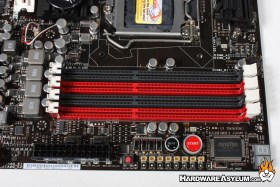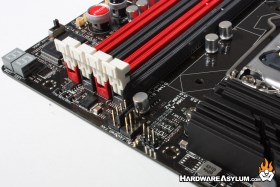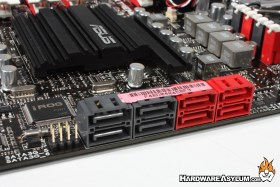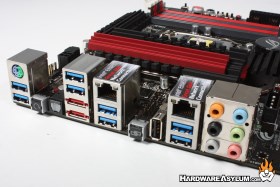Asus Maximus IV Extreme Motherboard Review
Author: Dennis Garcia
Published: Monday, August 08, 2011
Board Layout and Features Cont.
Dual channel memory comes standard on the Sandy Bridge and the Maximus IV supports DDR3 modules up to 2200Mhz with a maximum of 32GB usable. 24pin ATX power is located in the traditional location near the upper edge of the motherboard and out of the primary airflow.
Near the memory sockets you'll find a variety of bench top controls including power, reset and memory GO buttons. Voltage test points come standard on ROG motherboards and will allow you to sample all of the major voltages either with the included test leads or surface pad. PCI Express disable switches are located nearby and aid in multi GPU troubleshooting by disabling all of the PCI Express lanes going to that slot. Finally, you'll find a single LN2 switch located below the Debug LED that helps remedy the CBB and allow the system to boot at extremely low temperatures.
Near the memory sockets you'll find a variety of bench top controls including power, reset and memory GO buttons. Voltage test points come standard on ROG motherboards and will allow you to sample all of the major voltages either with the included test leads or surface pad. PCI Express disable switches are located nearby and aid in multi GPU troubleshooting by disabling all of the PCI Express lanes going to that slot. Finally, you'll find a single LN2 switch located below the Debug LED that helps remedy the CBB and allow the system to boot at extremely low temperatures.
There are actually two Debug LEDs on this motherboard. The first is located near the LN2 switch and features the traditional two digit readout. The second is located under the 24pin power connector and features four LEDs designed to indicate what part of the motherboard is failing.
Chassis cooling is handled by eight 4pin PWM fan headers scattered around the motherboard. Each of these is controllable from the BIOS or by the ASUS monitoring software.
Internal SATA connections number eight. The black connections are SATA3 spec while the red connections follow the new SATA6 connection standard direct from the P67 chipset and onboard Marvell 9182 controller.
Chassis cooling is handled by eight 4pin PWM fan headers scattered around the motherboard. Each of these is controllable from the BIOS or by the ASUS monitoring software.
Internal SATA connections number eight. The black connections are SATA3 spec while the red connections follow the new SATA6 connection standard direct from the P67 chipset and onboard Marvell 9182 controller.
The I/O on the Maximus IV Extreme is quite fun and features a single PS/2 connector for keyboard and mouse, a total of eight USB 3.0 ports, two Gigabit Ethernet connections (Intel gigabit controllers), two eSATA connections (in red), 8 channel analog audio and a single S/PDIF optical connection. ROG connect button with USB port. Bluetooth module with ROG activation switch (not pictured) and CMOS reset switch.





